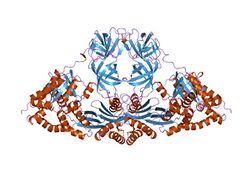Biology:UBA protein domain
| UBA | |||||||||
|---|---|---|---|---|---|---|---|---|---|
 The NMR structure of a UBA domain from the protein ubiquilin-1 (top, cyan) bound to ubiquitin (bottom, orange), illustrating the three-helix bundle structure of the UBA domain. Isoleucine 44, the center of a hydrophobic patch on the ubiquitin surface that interacts with a number of ubiquitin-binding domains, is highlighted in blue. Rendered from PDB: 2JY6.[1] | |||||||||
| Identifiers | |||||||||
| Symbol | UBA | ||||||||
| Pfam | PF00627 | ||||||||
| Pfam clan | CL0214 | ||||||||
| InterPro | IPR015940 | ||||||||
| PROSITE | PDOC50030 | ||||||||
| SCOP2 | 1efu / SCOPe / SUPFAM | ||||||||
| CDD | cd00194 | ||||||||
| |||||||||
Ubiquitin-associated (UBA) domains are protein domains that non-covalently interact with ubiquitin through protein-protein interactions. Ubiquitin is a small protein that is covalently linked to other proteins as part of intracellular signaling pathways, often as a signal for protein degradation. UBA domains are among the most common ubiquitin-binding domains.[2][3]
Function
Proteins containing UBA domains are involved in a variety of additional cell processes, such as nucleotide excision repair (NER), spindle pole body duplication, and cell growth.[4]
Protein degradation via the ubiquitin proteasome system (UPS) allows the cell to selectively negatively regulate intracellular proteins. Protein degradation helps to maintain protein quality control, signalling, and cell cycle progression.[5][6] UBA has been proposed to limit ubiquitin chain elongation and to target polyubiquitinated proteins to the 26S proteasome for degradation.[7] They have been identified in modular proteins involved in protein trafficking, DNA repair, proteasomal degradation, and cell cycle regulation.
Structure
UBA domains have a common sequence motif of approximately 45 amino acid residues.[8] They fold into three-helix bundle structures.[2]
Examples
The human homologue of yeast Rad23A is one example of a nucleotide excision-repair protein that contains both an internal and a C-terminal UBA domain. The solution structure of human Rad23A UBA(2) showed that the domain forms a compact three-helix bundle.[10]
Comparison of the structures of UBA(1) and UBA(2) reveals that both form very similar folds and have a conserved large hydrophobic surface patch which may be a common protein-interacting surface present in diverse UBA domains. Evidence that ubiquitin binds to UBA domains leads to the prediction that the hydrophobic surface patch of UBA domains interacts with the hydrophobic surface on the five-stranded beta-sheet of ubiquitin.[11]
This domain is similar in sequence to the N-terminal domain of translation elongation factor EF1B (or EF-Ts) from bacteria, mitochondria and chloroplasts.[9]
References
- ↑ "Affinity makes the difference: nonselective interaction of the UBA domain of Ubiquilin-1 with monomeric ubiquitin and polyubiquitin chains". Journal of Molecular Biology 377 (1): 162–80. March 2008. doi:10.1016/j.jmb.2007.12.029. PMID 18241885.
- ↑ 2.0 2.1 "Ubiquitin-binding domains - from structures to functions". Nature Reviews. Molecular Cell Biology 10 (10): 659–71. October 2009. doi:10.1038/nrm2767. PMID 19773779.
- ↑ "Ubiquitin-binding proteins: decoders of ubiquitin-mediated cellular functions". Annual Review of Biochemistry 81 (1): 291–322. 7 July 2012. doi:10.1146/annurev-biochem-051810-094654. PMID 22482907.
- ↑ "Ubiquitin-like and ubiquitin-associated domain proteins: significance in proteasomal degradation". Cellular and Molecular Life Sciences 66 (17): 2819–33. September 2009. doi:10.1007/s00018-009-0048-9. PMID 19468686.
- ↑ "Identification of a functional docking site in the Rpn1 LRR domain for the UBA-UBL domain protein Ddi1". BMC Biology 9: 33. May 2011. doi:10.1186/1741-7007-9-33. PMID 21627799.
- ↑ "Structural analysis of the UBA domain of X-linked inhibitor of apoptosis protein reveals different surfaces for ubiquitin-binding and self-association". PLOS ONE 6 (12): e28511. 2011. doi:10.1371/journal.pone.0028511. PMID 22194841. Bibcode: 2011PLoSO...628511T.
- ↑ "The rice HGW gene encodes a ubiquitin-associated (UBA) domain protein that regulates heading date and grain weight". PLOS ONE 7 (3): e34231. 2012. doi:10.1371/journal.pone.0034231. PMID 22457828. Bibcode: 2012PLoSO...734231L.
- ↑ "The UBA domain: a sequence motif present in multiple enzyme classes of the ubiquitination pathway". Trends in Biochemical Sciences 21 (5): 172–3. May 1996. doi:10.1016/S0968-0004(96)30015-7. PMID 8871400.
- ↑ 9.0 9.1 Kawashima, Takemasa; Berthet-Colominas, Carmen; Wulff, Michael; Cusack, Stephen; Leberman, Reuben (8 February 1996). "The structure of the Escherichia coli EF-Tu· EF-Ts complex at 2.5 Å resolution". Nature 379 (6565): 511–518. doi:10.1038/379511a0. PMID 8596629. Bibcode: 1996Natur.379..511K.
- ↑ "Structure of a human DNA repair protein UBA domain that interacts with HIV-1 Vpr". Nature Structural Biology 5 (12): 1042–7. December 1998. doi:10.1038/4220. PMID 9846873.
- ↑ "Solution structures of UBA domains reveal a conserved hydrophobic surface for protein-protein interactions". Journal of Molecular Biology 319 (5): 1243–55. June 2002. doi:10.1016/S0022-2836(02)00302-9. PMID 12079361.
 |


